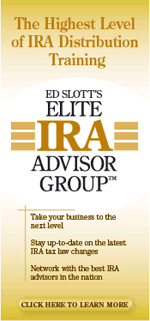
- Ed Slott CPA
- Ed as a Speaker
- Ed Slott's IRA Advisor Newsletter
- Shopping Cart
- Discussion Forum
- Ed's Speaking Schedule
Assistance
HOLIDAY SEASON BRINGS YEAR-END TAX MOVES
|
The holiday season ushers in a time for family, friends and financial security. It is also a time to make some year-end IRA tax moves detailed in December's issue of Ed Slott's IRA Advisor Newsletter.
|

|
Inside IRA
Guest IRA Expert
|
|

Q: Is there any tax advantage of converting a "non-deductible" IRA to a Roth IRA vs. a traditional deductible IRA to a Roth IRA? I'm asking because the non-deductible has "original" cost basis which is tax-free, and it would seem to make sense to convert as much non-deductible IRA as possible, but only if the conversion implies no taxation. Please clarify. A: You have a good idea to convert a non-deductible IRA to a Roth IRA. Unfortunately it does not work that way unless that is the only IRA you have and all the money in that IRA is non-deductible. There is a little-known rule called the "pro-rata rule", which states that when an IRA contains both non-deductible and deductible funds, each dollar withdrawn or converted from the IRA will contain a percentage of tax-free and taxable funds. The same is true even if you have separate IRAs with non-deductible and deductible contributions. All IRAs must be considered as one IRA for the pro-rata rule. For more questions and answers, CLICK HERE to visit The Slott Report, which is updated Monday-Friday with the latest technical expertise and company information. |
||
|
|||






